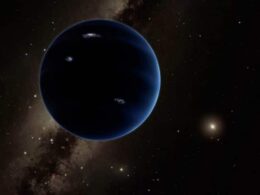Home / Space news /
« Most distant quasar in universe found | Hair bleach is found in deep space »
Can you discover a new icy world?
By Amanda Doyle on July 1, 2011 5:55 pm / no comments
Space enthusiasts are being given the chance to discover icy new worlds in the outer reaches of the Solar System. Their find might even be visited by NASA’s New Horizons probe after its fly-by of Pluto, becoming the furthest body from Earth ever visited by a spacecraft.
An impression of New Horizons' encounter with a KBO, showing the Sun in the distance Credit: Johns Hopkins University Applied Physics Laboratory/Southwest Research Institute (JHUAPL/SwRI)
Ice Hunters is a citizen science project which is part of the Zooniverse network. The most well known Zooniverse project is Galaxy Zoo, which allows people to help with classifying galaxy types. In a similar style, Ice Hunters is asking for people to help sift through millions of images on their website in order to find Kuiper Belt Objects (KBOs). KBOs are icy objects lying beyond the orbit of Pluto.
In order to find a KBO, stars need to be taken out of the picture. This is done for you by the website which aligns two images, which have been taken at different times, and then subtracts one image from the other. This technique should leave only non-stationary objects or objects that vary in brightness; in other words a KBO, asteroid or variable star.
While Ice Hunters’ main priority is to search for a KBO that New Horizons can visit, all the data will be put to good use as asteroid orbits are refined and variable stars will be added to the American Association of Variable Star Observers (AAVSO) database. According to Dr Pamela Gay, a member of the Ice Hunters team, over 7,000 people have joined Ice Hunters so far and over half of them have already classified images. While there aren’t any newly confirmed KBO discoveries yet, Dr Gay hopes there will be results in a few weeks.
The images used by Ice Hunters were taken by both the 8 metre Subaru telescope in Hawaii and the 6.5 metre Magellan telescope in Chile. These telescopes are large enough to detect KBOs despite their large distance from us.
“We expect most KBOs that we can reach to be in the range 40 – 46 astronomical units from the Sun (i.e., 40 – 46 times as far from the Sun as we are),” planetary scientist Dr John Spencer told Skymania News. “That’s where the Kuiper Belt is relatively dense and the amount of space New Horizons can reach is relatively wide.”
The KBO that will be selected for New Horizons to investigate has to be at least 50 kilometres across. “At this distance, the smallest KBOs we can find will have diameters of about 30 km, and if we’re lucky we might find one as big as 100 km or so”, explained Dr Spencer.
New Horizons was launched in 2006 and will reach Pluto in 2015, which is at an average distance of 5.9 billion kilometers from the Sun. It will be the first spacecraft to analyse the dwarf planet in detail. Even the Hubble Space Telescope cannot get more than a blurry image of Pluto.
After New Horizons has its close fly-by with Pluto and its largest moon Charon, it will head further into the unknown to visit one or two other KBOs. The targets will be chosen from the Ice Hunters database so that they are in the right place at the right time to earn a visit from New Horizons.
The KBO doesn’t have to be chosen until the probe is nearing Pluto, which still leaves a few years to find the right one. New Horizons would hope to reach this new KBO object within two to three years after visiting Pluto. Cameras on board the spacecraft will image the KBO on approach in order to alter the flight path in time to safely fly by the target.
Once at the target, New Horizons will map the surface and try to determine the composition and temperature. It will also search for any atmosphere or any satellites the object may have. New Horizons will then follow the Pioneer and Voyager spacecraft beyond the Kuiper Belt and out of our Solar System.
Ice Hunters can be found at www.icehunters.org
Reporter: Amanda Doyle


